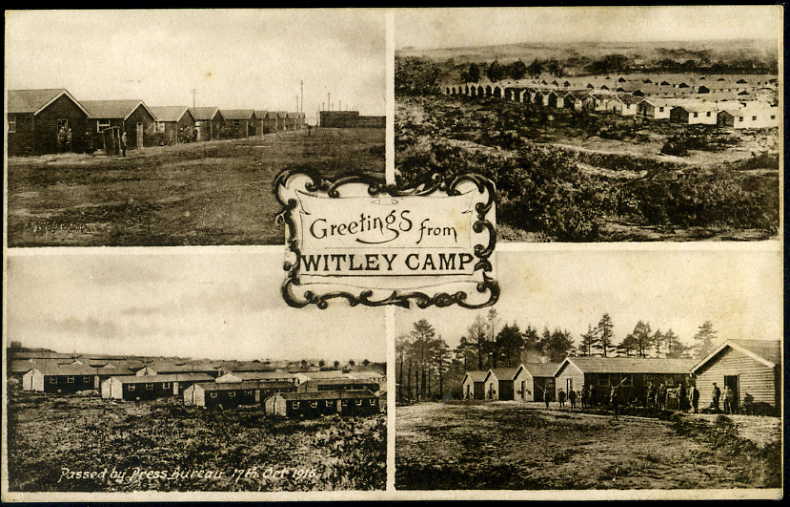202nd Battalion Witley Camp
near Godalming Surrey
|
Witley Military Camp, often simplified to Camp Witley, was a temporary army camp set up on Witley Common, Surrey, England. The camp was about 7 miles from Bramshott and appears to have been set up in the early part of the First World War. Camp Witley was one of three facilities in the Aldershot Command area and possibly established by the Canadian Army; the others being Bordon and Bramshott near Liphook. There are many references to the camp but in March
1915 one referance including the costs on the huts to the tax payer
apparently £13.00 per man, of which £4.00 represented
the hut and £9.00 for recreation room, stores, light, and so
forth. The camp at this time was apparently under construction still. I also recently have found a reference to the camp
being discussed in parliament dated 4th December 1916
There is a description of the camp recorded in a book
The 60th C.F.A. BATTERY BOOK WITLEY Camp, of which Milford Camp
- the Artillery quarters - forms a part, had for some time Witley is in an ideal situation for
the training of artillery. It is surrounded by large areas of roll-
Beautiful old-world villages, and
spots of historical and artistic interest lie within easy distance
; good
The 202nd battalion arrived at Witley Camp
on the 30th November 1916 but no quarters were availably so the battalion
was split and quartered with six other battalions for one week. They
were then gathered together and proceeded to Bramshott Camp where
normal training commenced. On the 30th December the 202nd Battalion
again moved to Witley Camp going to the 12th Training Brigade in the
south camp before being absorbed into the 5th Canadian Infantry Division,
13th Canadian Brigade in February 1917 and later on the 28th May 1918
the battalion was absorbed into the 9th Canadian Reserve Battalion.
The 202nd mostly ended up in the 10th, 31st, 49th, 51st Battalions
C.E.F. as reinforcements to the front lines in France. |
|
|
|
Witley Camp Postcard Army Service Corps 17th October 1916
|
 |
|
 |
|
 |
|
 |
|
 |
|
 |
|
 |
|
 |
|
 |
|
 |
|
 |
|
 |
|
 |
|
 |
|
 |
|
 |
|
 |
|
 |
|
 |
Witley Camp Postcard Camp South The 202nd Battalion quartered in the south camp post December 1916 (from the 202nd War Dairy) |
 |
|
 |
|
 |
|
 |
|
 |
|
 |
|
 |
|
 |
|
 |
|
|
|
Camp Witley |
 |
|
 |
|
 |
|
 |
|
 |
|
 |
|
 |
|
 |
|
 |
|
 |
|
 |
|
 |
Witley Camp Postcard
Witley Church The Canadian Colours were deposited in this Church
The 202nd battalion
colours were |
 |
Witley Camp Postcard
Witley Church |
 |
Witley Camp Postcard
5 Heart Chapel Witley 1916 |
 |
|
 |
|
 |
|
 |
|
 |
|
 |
|
 |
|
 |
|
 |
|
 |
|
 |
|
 |
|
 |
|
  |

